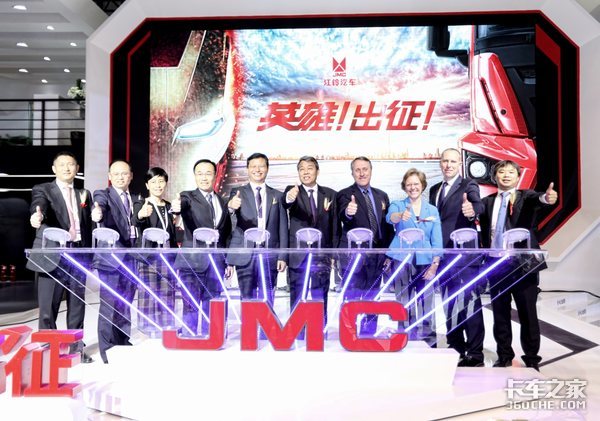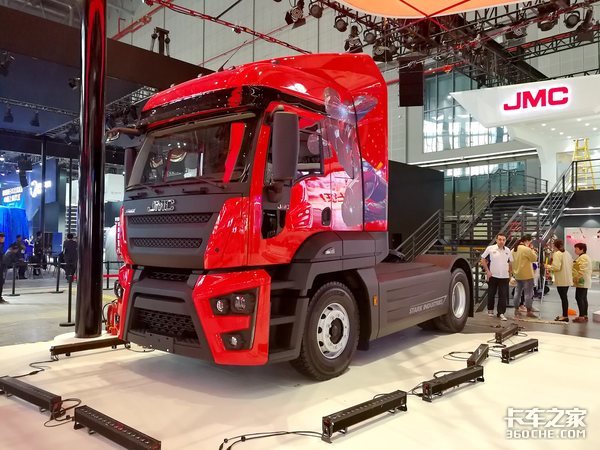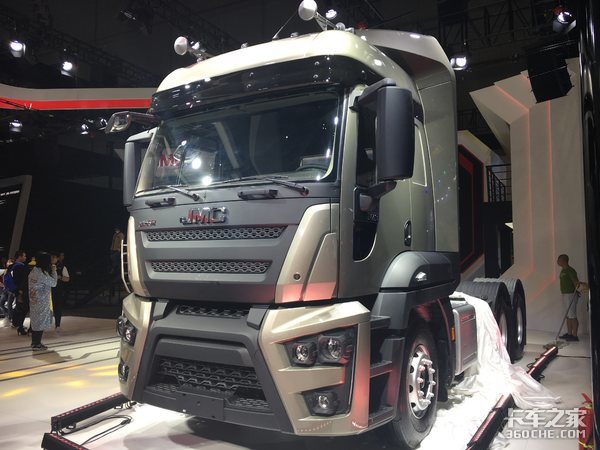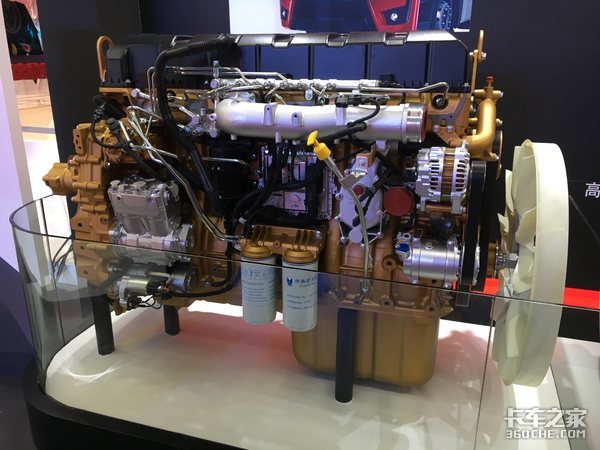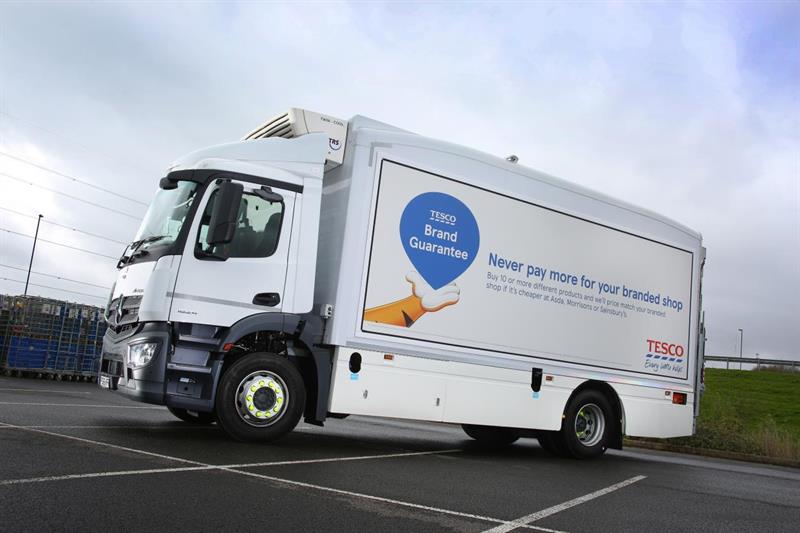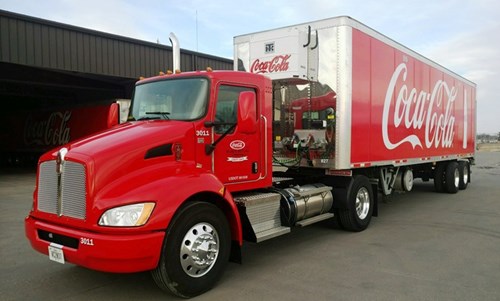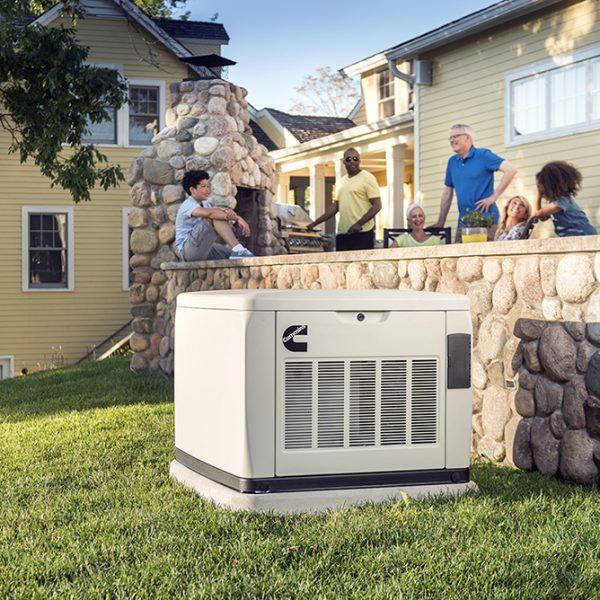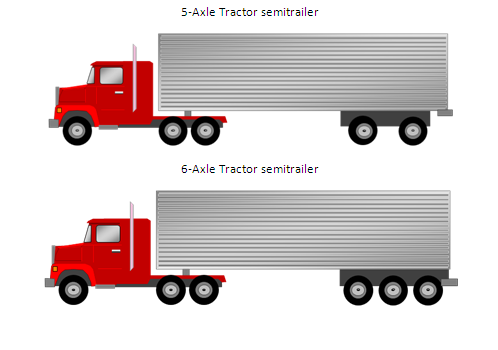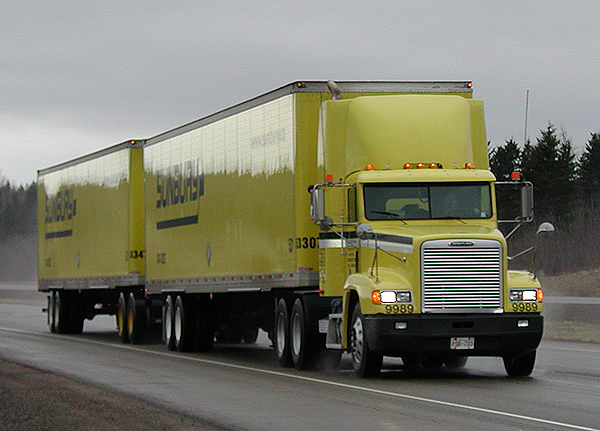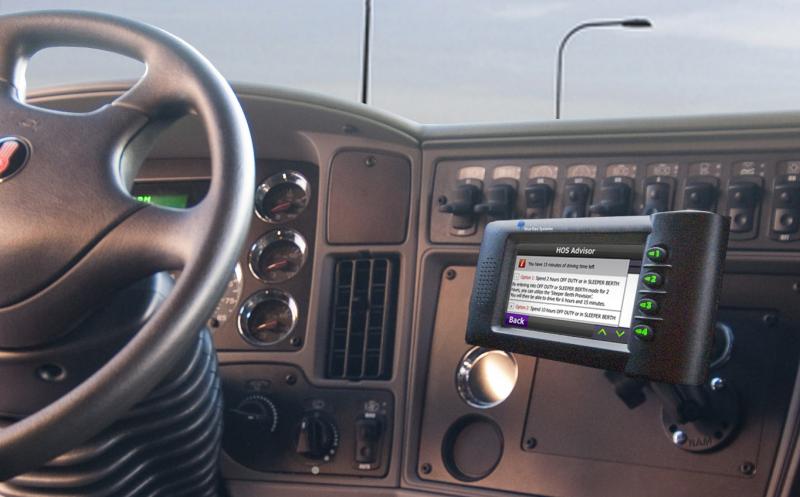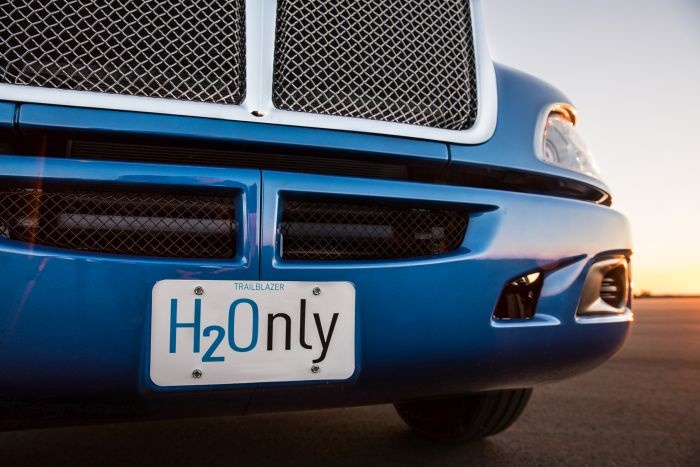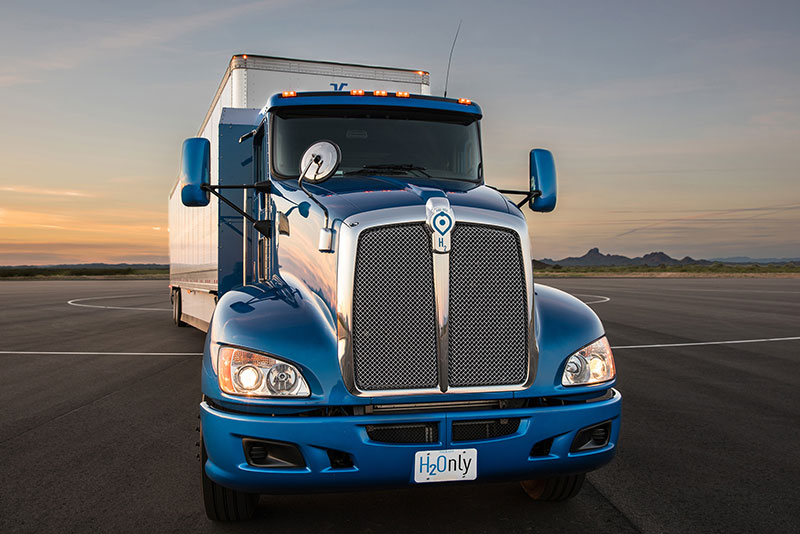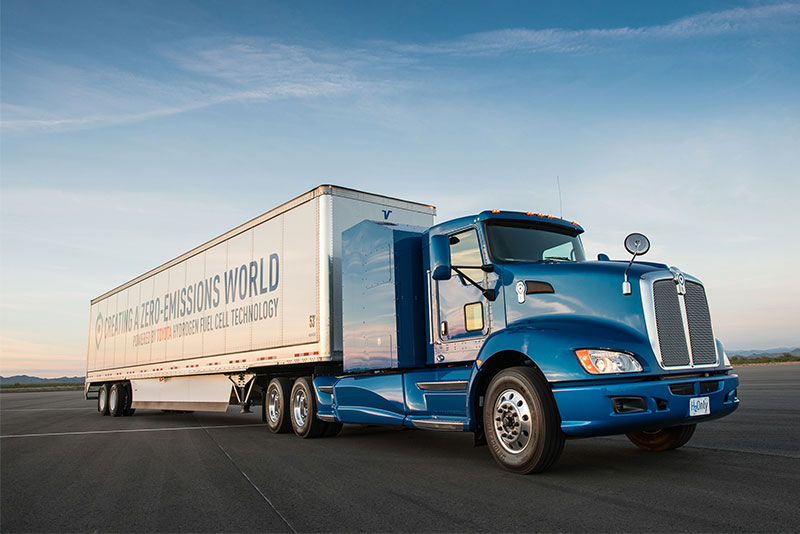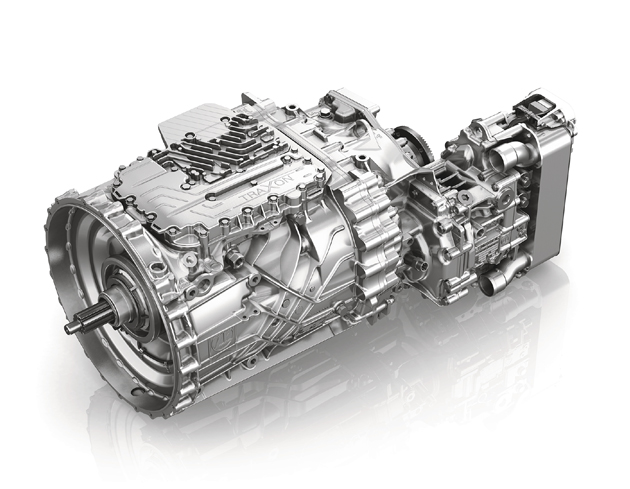
kscarbel2
Moderator-
Posts
17,893 -
Joined
-
Days Won
86
Content Type
Profiles
Forums
Gallery
Events
Blogs
BMT Wiki
Collections
Store
Everything posted by kscarbel2
-
China market Ford Cargo heavy tractor arrives
kscarbel2 replied to kscarbel2's topic in Trucking News
Yes, Bob. Both Ford Otosan and Ford corporate. -
China market Ford Cargo heavy tractor arrives
kscarbel2 replied to kscarbel2's topic in Trucking News
360 Truck / April 19, 2017 The Ford Cargo-based JMV heavy truck made its market debut at the 17th Shanghai international auto show on April 17. The China market Ford Cargo, wearing the JMC badge, utilizes Ford heavy truck technology including its engine, cab and chassis. The truck is positioned opposite the market’s leading heavy truck competition. The China market Ford Cargo utilizes locally produced FUWA lightweight drive axles. FUWA has received Ford's Q1 quality certification. . -
Associated Press / April 19, 2017 Oshkosh Corp. has secured $258 million in orders to rebuild trucks and manufacture trailers for the Army. Oshkosh will rebuild 670 heavy tactical vehicles. The Army says it saves about 25 percent when a truck is rebuilt rather than completely replaced. It refurbishes trucks with bullet holes, bent frames and mangled wheels to become like-new vehicles. Oshkosh will also produce 356 vehicle trailers in the latest round of Army orders.
-
Tesco front of the queue to trial new refrigeration system
kscarbel2 posted a topic in Trucking News
Transport Engineer / April 19, 2017 Tesco is trialing Carrier Transicold multi-temperature refrigeration units, which run on hydro-electric power generated by the truck’s Euro 6 engine. The units have been fitted to two Mercedes-Benz Antos rigids and are the first trucks with alternative refrigeration technology to join Tesco’s fleet. “We are delighted to be one of the first customers trialling this new type of engineless refrigeration unit offering significant environmental benefits,” says Caroline Sindrey, engineering manager for Tesco. “The new system offers huge potential to help us reduce our carbon footprint through lower emissions and diesel consumption, as well as decreasing air and noise pollution. We also hope it will reduce maintenance and fuel costs across our fleet of vehicles in the long term.” The systems are driven by an Eco-Drive GenSet power unit, which is powered by a hydraulic pump connected to the truck’s engine power take-off. The hydraulic pump drives a generator that delivers electrical power to the refrigeration unit and provides a continual refrigeration capacity even at the truck’s standard idle speed. With a PIEK-compliant noise level rating as standard, the units are suited to urban deliveries. With two refrigerating circuits fed by separate fully-hermetic scroll compressors, items such as drive belts, pulleys and compressor shaft seals are eliminated, which in turn optimises uptime and refrigerant containment. This configuration – coupled to two economisers and a wide surface condenser – means the system provides a cooling capacity of up to 18,400W. . -
Scania Group Press Release / April 19, 2017 It took 5 years of testing, often on open roads, before the next generation was launched. Still, we managed to keep it under wraps. .
-
DAF Trucks / April 19, 2017 Every journey should start efficiently. #DAFreveals . . . . . .
-
Kenworth Truck Co. / April 19, 2017 ATLANTIC, Iowa, April 19, 2017 - Atlantic Coca-Cola Bottling Company, has been in the Tyler family for more than 100 years. Beginning as an ice cream company in 1905, the company soon expanded into soft drinks named “Tyler’s Flavors.” That changed in 1929 when Atlantic acquired franchise rights to bottle and distribute Coca-Cola. The company has been growing ever since. Growth over the past three years has been unusually rapid as the company expanded from two locations to nine, and from 200 to 700 employees. Overseeing Atlantic’s growth is owner and chairman Jim Tyler. His son, Kirk Tyler, is CEO and company president. Rob Feeney runs day-to-day operations, along with Ned Brown, senior vice president of operations Brian Harris is fleet maintenance manager. Atlantic’s service area now covers most of Iowa and extends into a few neighboring states. The 120-truck fleet includes a growing roster of Kenworths, featuring T370 route trucks powered by PACCAR PX-9 [Cummins ISL 8.9L] engines and Allison 6-speed automatic transmissions. Atlantic route trucks often run 10-plus years before trade-in, so long term durability is critical. “The durability factor was evident to us from the beginning,” said Brian Harris, fleet maintenance manager. “With our very first T370, as we were putting the box on it, right away we noticed the frame is built much sturdier than other brands of trucks we’ve owned. Right there, we determined to get more Kenworths. It’s a heavier built truck.” Since purchasing its first T370, Atlantic has ordered several new T370s every year over the past five or six years, including 12 new T370s in 2016. “The Kenworth T370 is simply a better route truck,” said Brown. “We think it is important to have equipment that’s exceptional. Image matters. We produce a premium product and want premium trucks to deliver it. Kenworth trucks do a much better job of drawing attention to quality. It’s a moving billboard that speaks well for our company.” Atlantic’s T370 straight trucks haul up to one thousand cases of Coca-Cola products, or 12 pallets. Some T370 tractors haul 35-foot trailers that carry 20 pallets. Drivers make 12 to 20 stops, jumping in and out of the cab all day long. “Our drivers tell us the Kenworth cab is comfortable and better built than other trucks,” said Harris. “The T370 is quieter going down the road, the doors shut tight and the interior is nicer all around.” The company works with MHC Kenworth – Des Moines for sales and service. With rapid growth, said Brown, “it’s nice to have our Kenworth dealer to rely on. MHC Kenworth has been instrumental in helping us spec the delivery truck we need. For example, we’ve done some things on the truck to improve efficiency. Some of our locations in the new territory require our route trucks to travel farther distances. We wanted a bigger fuel tank, and we wanted to move it to the driver side. The dealer helped us reconfigure all that. “The T370s help sell our product,” Brown concludes. “When you’re driving down the road and see a great-looking truck, you make a connection with the product, and you want to buy that product. Our fleet has to look good. We haven’t had any problems with our Kenworth trucks. There really is no comparison between Kenworth and other trucks.” .
-
Ideas for Using Your Tax Refund for Your Home Leah Ingram, Cummins Press Release / April 19, 2017 Invest in a standby generator We live in a beach town in New Jersey that was one of the hardest hit during 2012’s Superstorm Sandy. It’s no surprise that nearly every house in our neighborhood has a standby generator. These are the generators that run on natural gas or propane. Unlike portable generators that can be noisy and require manual set-up, running cords and gasoline, standby generators cycle on automatically as soon as the power goes off. Once you’ve lost power for an extended period of time and suffered the inconveniences that come with being powerless, you quickly realize the importance of a standby generator. Cummins has an online quiz you can take to evaluate your home generator needs. This Cummins quiz helps you determine how much power your home needs to keep running when the power is out and can help you select the right standby generator for you. Take the quiz now at https://homegenerators.cummins.com/ Another reason to use your tax refund to invest in a standby generator–hurricane season is just around the corner. Hurricane Season is officially May 1 through December 1, butyou never know when during the season you could get hit. Remember: Superstorm Sandy happened days before Halloween–and days before the hurricane season would have been officially over. Realtors tell me that when it comes to selling a home in hurricane-prone states, a standby generator can make your home stand out from others. This makes them more attractive to buyers who are looking for this premium amenity and, dare I say, necessity in a place where power outages come with the weather. .
-
The Electronic Logging Device (ELD) Controversy
kscarbel2 replied to kscarbel2's topic in Trucking News
Texas to require intrastate drivers to use ELDs by 2019, other states to follow James Jaillet, Overdrive / April 19, 2017 Texas has updated its hours of service code to require intrastate truckers to use electronic logging devices to record duty status. Truck operators in the state must begin using the devices by Dec. 19, 2019. The effective date of the federal government’s mandate requiring ELDs for interstate truckers is Dec. 18, 2017. Texas’ new regs are sparse on detail, simply pointing to the U.S. DOT code requiring ELDs and establishing an effective date. The minimum device spec’s will be the same as the federal government’s mandate, but it’s unclear whether the exemptions to the federal mandate will apply to intrastate operators. Overdrive has reached out to the Texas Department of Public Safety regarding possible exemptions and will report on the information will it becomes available. The state specifies an exemption for truckers hauling agricultural products within a 150-air-mile radius of a commodities’ point of origination or distribution during harvest season. Though Texas appears to be the first state to issue an ELD requirement for intrastate truckers, other states will likely soon follow, says Joe Rajkovacz, head of regulatory affairs for the Western States Trucking Association. Federal regulations require states to adopt laws for intrastate truckers compatible with national laws. Most states will fall in line without fanfare, he says, but there could be a few standouts, he said, at least initially. Which states may try to rebut the U.S. DOT on adopting an ELD requirement for intrastate truckers isn’t clear, he says, but there’s already some drama playing out on the issue in his home state, California. “It remains to be seen if this state falls in line,” he says. Rajkovacz says looser intrastate laws on hours of service — 12 hours of daily driving time — has the state’s regulators wondering if the cost of the mandate for intrastate operators will yield a safety benefit. “In the end,” he says, federal laws requiring state compliance “will probably win the day.” -
Toyota Explores Heavy Truck Hydrogen Fuel Cell Application
kscarbel2 replied to kscarbel2's topic in Trucking News
Toyota unveils fuel-cell Class 8 tractor prototype Fleet Owner / April 19, 2017 Dubbed “Project Portal” its runs on electricity generated by a hydrogen-powered fuel cell. Toyota Motor North America (TMNA) officially took the wraps off its “Project Portal” prototype Class 8 tractor this week – a hydrogen fuel cell system designed for heavy duty trucks operating at the Port of Los Angeles. The OEM said this “proof of concept” zero-emission truck is fully functioning, with the power and torque capacity to conduct port drayage operations while emitting nothing but water vapor. It will be part of a feasibility study that begins this summer which will examine the potential of fuel cell technology in heavy duty applications “By bringing this heavy duty, zero emission hydrogen fuel cell proof of concept truck to the Port, Toyota has planted a flag that we hope many others will follow,” said Mary Nichols, chair of the California Air Resources Board (CARB), in a statement. “CARB will be following the progress of this feasibility study with interest, as we look to develop the best mix of regulations and incentives to rapidly expand the market for the cleanest, most efficient big trucks to meet the need for dramatic change in the freight sector,” she added. “Hydrogen fuel cell vehicles play a role in California’s efforts to achieve greenhouse gas emission reduction goals, improve air quality, and reduce our reliance on fossil fuels,” added Janea Scott with the California Energy Commission (CEC), which is why the CEC making invests in the refueling infrastructure needed to support adoption of these vehicles, Scott noted. The Project Portal tractor generates more than 670 hp and 1,325 lb.-ft. of torque from two Mirai fuel cell stacks and a 12 kilowatt-per-hour (kWh) battery – a relatively small battery to support Class 8-type loads, Toyota noted. The concept’s gross combined weight capacity is 80,000 lbs., and its estimated driving range is more than 200 miles per fill, under normal drayage operation, noted Bob Carter, executive vice president with TMNA. “Toyota believes that hydrogen fuel cell technology has tremendous potential to become the powertrain of the future,” he said. “With Project Portal, we’re proud to help explore the societal benefits of a true zero emission heavy-duty truck platform.” Informational photo gallery - http://fleetowner.com/running-green/breaking-down-project-portal#slide-0-field_images-216521 -
TCA Implores Congress NOT to Raise Truck Weights
kscarbel2 replied to kscarbel2's topic in Trucking News
Manufacturing groups ask Trump to raise truck weights Fleet Owner / April 19, 2017 ELD exemptions also requested in response to executive order. Increasing federal truck size-and-weight limits and granting more exemptions from the electronic logging device (ELD) mandate were among the recommendations manufacturing groups sent to the Trump administration. About 170 comments were posted to regulations.gov in response to an executive order signed by President Trump during his first week in office aimed at “streamlining permitting and reducing regulatory burdens for domestic manufacturing.” The comments were filed to the U.S. Commerce Secretary Wilbur Ross, who must submit a plan of action to the president by the end of May. The Environmental Protection Agency (EPA) drew the most criticism, with many of the filings focusing on non-transportation concerns. However, a number of associations clearly believe the current federal limit of 80,000 lbs. must be raised. For example, a joint filing from the American Forest and Paper Association (AFPA), the Beer Institute, and the Agriculture & Commodities Transportation Coalition urged the modernization of federal truck weight limits to “make this country a more attractive site” for manufacturing. The AFPA said an increase to 91,000 lbs. with use of an additional trailer axle would cut as many as 1.4 million truck trips annually and reduce annual truck miles by as much as 250 million. “This single reform has the potential to generate huge cost savings for U.S. businesses and improve the outlook for manufacturing jobs in the United States,” the groups wrote. While they did not explicitly state their weight preference, they made multiple references to a limit of 91,000 lbs. Calling transportation “one of the most significant costs” for its members, the Composite Panel Association encouraged the Trump administration to work with Congress to approve the 91,000-lb. limit. It noted several states including Wisconsin already have changed laws to accommodate higher weights. Domtar, a manufacturer of wood fiber-based products, requested raising the limit to 97,000 lbs. Domtar said the current limit creates inefficiencies for companies like itself, which haul heavy paper products. It has to use half-empty trucks because the “weight limit is reached long before the physical capacity of the tractor-trailer is reached.” Current weight rules are “stuck in the last century, as they fail to account for significant improvements in vehicle safety and pavement technology,” Domtar said. Also speaking out on truck productivity was the National Association of Manufacturers (NAM), which asked the Department of Transportation (DOT) to study the cost-benefit and safety analysis of both 91,000-lb. vehicles and twin 33-ft. trailers. The need for longer and/or heavier trucks is a topic that’s seeing new life on several fronts of late. For example, John Larkin – managing director and head of transportation capital markets research for Stifel Capital Markets – noted that the issue came up during his visit to the annual meeting of the National Strategic Shippers Transportation Council (NASSTRAC) last week. “The logic to make … existing power units more productive may well overwhelm the emotional notion that 33-ft. trailers must be more unsafe than 28’s [28-ft. units],” he said in a research note. “One participant expressed the thought that the feds should not stop with 33’s but should look at other size and weight combinations that are consistent with the [federal] bridge formula (used to design and build bridges on our interstate system) and [that] therefore would not accelerate the rate of pavement and bridge deterioration. “ Larkin added that the longer vehicle configurations that should be evaluated include three-axle semi-trailers, turnpike twins, triple 28’s, Rocky Mountain doubles, etc. “The broad adoption of more far-reaching changes in truck size and weight laws would make high-quality drivers more productive, reduce the number of trucks on the road, reduce the need for new highway capacity, etc.,” he emphasized. Turning back to recommendations, NAM also wants the Federal Motor Carrier Safety Administration (FMCSA) to identify ways to minimize unnecessary burdens and costs as the final rule requiring commercial drivers to use ELDs to record hours of service (HOS) data goes into effect in December this year. As an example, it suggested an exemption for livestock haulers. The Associated General Contractors of America wants a similar exemption for construction drivers, while the Treated Wood Council requested that small businesses - “under 25 trucks” - be granted an exemption. Offering more HOS flexibility for construction and other short-haul drivers was recommended in comments filed by the American Road & Transportation Builders Association. Looking deeper at the HOS rule, NAM pointed to the mandatory 30-minute break within the first eight hours of driving as another measure worth a fresh review. It also called on the expansion of truck parking facilities to ensure truckers can safely meet rest regulations. NAM’s 42-page filing left almost no stone unturned. From streamlining the testing of heavy-duty engines between EPA and California, tweaking the Food Safety Modernization Act, providing for a mid-term evaluation of fuel economy rules for light-duty vehicles and ensuring a coordinate government process when developing autonomous driving guidelines to avoid conflicts, there were more than a dozen freight transportation suggestions offered up. The association was among several calling for the suspension or elimination of the conflict minerals rule established by the Securities and Exchange Commission (SEC). Aimed at preventing the use of certain minerals originating in the Democratic Republic of Congo and neighboring countries, publicly traded manufacturers said it is a costly and nearly impossible task, especially for small firms that supply to larger ones. Earlier this month, the SEC said it is considering options after a court declared the rule violates the First Amendment of the Constitution. Another item that drew the ire of multiple commenters was an Obama administration rule making many more workers eligible for overtime pay. However, a U.S. District Court in Texas issued a temporary injunction in November, preventing it from taking effect and giving the Trump administration until May to determine its position. It would have doubled to $47,476 the salary a worker could make and be eligible for overtime pay. . -
TCA Implores Congress NOT to Raise Truck Weights
kscarbel2 replied to kscarbel2's topic in Trucking News
Manufacturing Groups Ask Trump to Raise Truck Weights Trailer/Body Builders / April 19, 2017 Increasing federal truck size-and-weight limits and granting more exemptions from the electronic logging device (ELD) mandate were among the recommendations manufacturing groups sent to the Trump administration. About 170 comments were posted to regulations.gov in response to an executive order signed by President Trump during his first week in office aimed at “streamlining permitting and reducing regulatory burdens for domestic manufacturing.” The comments were filed to the U.S. Commerce Secretary Wilbur Ross, who must submit a plan of action to the president by the end of May. The Environmental Protection Agency (EPA) drew the most criticism, with many of the filings focusing on non-transportation concerns. However, a number of associations clearly believe the current federal limit of 80,000 lbs. must be raised. For example, a joint filing from the American Forest and Paper Association (AFPA), the Beer Institute, and the Agriculture & Commodities Transportation Coalition urged the modernization of federal truck weight limits to “make this country a more attractive site” for manufacturing. The AFPA said an increase to 91,000 lbs. with use of an additional trailer axle would cut as many as 1.4 million truck trips annually and reduce annual truck miles by as much as 250 million. “This single reform has the potential to generate huge cost savings for U.S. businesses and improve the outlook for manufacturing jobs in the United States,” the groups wrote. While they did not explicitly state their weight preference, they made multiple references to a limit of 91,000 lbs. Calling transportation “one of the most significant costs” for its members, the Composite Panel Association encouraged the Trump administration to work with Congress to approve the 91,000-lb. limit. It noted several states including Wisconsin already have changed laws to accommodate higher weights. Domtar, a manufacturer of wood fiber-based products, requested raising the limit to 97,000 lbs. Domtar said the current limit creates inefficiencies for companies like itself, which haul heavy paper products. It has to use half-empty trucks because the “weight limit is reached long before the physical capacity of the tractor-trailer is reached.” Current weight rules are “stuck in the last century, as they fail to account for significant improvements in vehicle safety and pavement technology,” Domtar said. Also speaking out on truck productivity was the National Association of Manufacturers (NAM), which asked the Department of Transportation (DOT) to study the cost-benefit and safety analysis of both 91,000-lb. vehicles and twin 33-ft. trailers. The need for longer and/or heavier trucks is a topic that’s seeing new life on several fronts of late. For example, John Larkin – managing director and head of transportation capital markets research for Stifel Capital Markets – noted that the issue came up during his visit to the annual meeting of the National Strategic Shippers Transportation Council (NASSTRAC) last week. “The logic to make … existing power units more productive may well overwhelm the emotional notion that 33-ft. trailers must be more unsafe than 28’s [28-ft. units],” he said in a research note. “One participant expressed the thought that the feds should not stop with 33’s but should look at other size and weight combinations that are consistent with the [federal] bridge formula (used to design and build bridges on our interstate system) and [that] therefore would not accelerate the rate of pavement and bridge deterioration. “ Larkin added that the longer vehicle configurations that should be evaluated include three-axle semi-trailers, turnpike twins, triple 28’s, Rocky Mountain doubles, etc. “The broad adoption of more far-reaching changes in truck size and weight laws would make high-quality drivers more productive, reduce the number of trucks on the road, reduce the need for new highway capacity, etc.,” he emphasized. Turning back to recommendations, NAM also wants the Federal Motor Carrier Safety Administration (FMCSA) to identify ways to minimize unnecessary burdens and costs as the final rule requiring commercial drivers to use ELDs to record hours of service (HOS) data goes into effect in December this year. As an example, it suggested an exemption for livestock haulers The Associated General Contractors of America wants a similar exemption for construction drivers, while the Treated Wood Council requested that small businesses - “under 25 trucks” - be granted an exemption. Offering more HOS flexibility for construction and other short-haul drivers was recommended in comments filed by the American Road & Transportation Builders Association. Looking deeper at the HOS rule, NAM pointed to the mandatory 30-minute break within the first eight hours of driving as another measure worth a fresh review. It also called on the expansion of truck parking facilities to ensure truckers can safely meet rest regulations. NAM’s 42-page filing left almost no stone unturned. From streamlining the testing of heavy-duty engines between EPA and California, tweaking the Food Safety Modernization Act, providing for a mid-term evaluation of fuel economy rules for light-duty vehicles and ensuring a coordinate government process when developing autonomous driving guidelines to avoid conflicts, there were more than a dozen freight transportation suggestions offered up. The association was among several calling for the suspension or elimination of the conflict minerals rule established by the Securities and Exchange Commission (SEC). Aimed at preventing the use of certain minerals originating in the Democratic Republic of Congo and neighboring countries, publicly traded manufacturers said it is a costly and nearly impossible task, especially for small firms that supply to larger ones. Earlier this month, the SEC said it is considering options after a court declared the rule violates the First Amendment of the Constitution. Another item that drew the ire of multiple commenters was an Obama administration rule making many more workers eligible for overtime pay. However, a U.S. District Court in Texas issued a temporary injunction in November, preventing it from taking effect and giving the Trump administration until May to determine its position. It would have doubled to $47,476 the salary a worker could make and be eligible for overtime pay. -
Toyota Explores Heavy Truck Hydrogen Fuel Cell Application
kscarbel2 replied to kscarbel2's topic in Trucking News
Toyota to Road-Test Class 8 Hydrogen Fuel Cell Truck Heavy Duty Trucking / April 19, 2017 After teasing the concept late last year, Toyota Motor North America has announced plans to operate a Class 8 hydrogen fuel cell truck in real-world use in Southern California this summer, dubbing the effort "Project Portal." The truck proof of concept will seek to determine the feasibility of fuel cell technology for heavy-duty trucks, specifically in drayage operations. The study is part of the Port of Los Angeles’s Clean Air Action Plan, which is aimed at reducing emissions in and around the Ports of Los Angeles and Long Beach. “By bringing this heavy-duty, zero-emission hydrogen fuel cell proof-of-concept truck to the Port, Toyota has planted a flag that we hope many others will follow,” said Mary D. Nichols, chair, California Air Resources Board. “CARB will be following the progress of this feasibility study with interest, as we look to develop the best mix of regulations and incentives to rapidly expand the market for the cleanest, most efficient big trucks to meet the need for dramatic change in the freight sector.” Project Portal is a fully functioning, heavy-duty truck with the power and torque capacity to conduct port drayage operations while producing only water vapor as emissions. The truck will generate more than 670 horsepower and 1,325 lb.-ft. of torque from two Mirai fuel cell stacks and a 12-kilowatt-hour battery. The concept vehicle will have a gross combined weight capacity of 80,000 pounds and an estimated range of more than 200 miles per fill in normal drayage operation. “Hydrogen fuel cell vehicles play a role in California’s efforts to achieve greenhouse gas emission reduction goals, improve air quality, and reduce our reliance on fossil fuels,” said Janea A.Scott, commissioner, California Energy Commission. “The Commission applauds Toyota for putting this cutting edge technology to use in a heavy-duty freight proof of concept. This demo will show how fuel cells can help support the heavy-duty sector’s efforts to increase efficiency, transition to zero-emission technologies, and increase competitiveness.” . -
Toyota Explores Heavy Truck Hydrogen Fuel Cell Application
kscarbel2 replied to kscarbel2's topic in Trucking News
. . . -
Toyota Explores Heavy Truck Hydrogen Fuel Cell Application
kscarbel2 replied to kscarbel2's topic in Trucking News
Toyota North America unveils hydrogen-fuel-cell heavy-duty truck proof-of-concept; twin Mirai fuel cell stacks Green Car Congress / April 19, 2017 Toyota Motor North America, Inc. (TMNA) revealed “Project Portal”—a hydrogen fuel cell system designed for heavy-duty trucks applied in a Class 8 truck for use at the Port of Los Angeles (POLA). Announced at a press conference with Port officials and representatives from California Air Resources Board (CARB) and the California Energy Commission (CEC), the zero-emission truck proof-of-concept will take part in a feasibility study examining the potential of fuel cell technology in heavy duty applications. The study will begin this summer and contribute to the Port’s Clean Air Action Plan, which has significantly reduced harmful emissions from operations at the Ports of Long Beach and Los Angeles since 2005. As they did with the Prius and the Mirai, Toyota is taking a leap into the future of technology. By bringing this heavy-duty, zero-emission hydrogen fuel cell proof-of-concept truck to the Port, Toyota has planted a flag that we hope many others will follow. CARB will be following the progress of this feasibility study with interest, as we look to develop the best mix of regulations and incentives to rapidly expand the market for the cleanest, most efficient big trucks to meet the need for dramatic change in the freight sector. —Mary D. Nichols, Chair, California Air Resources Board (CARB) Project Portal is the next step in Toyota’s effort to broaden the application of zero-emission fuel cell technology that can serve a range of industries. It is a fully functioning heavy-duty truck with the power and torque capacity to conduct port drayage operations while emitting nothing but water vapor. Heavy-duty vehicles make up a significant percentage of the annual emissions output at the Port of Los Angeles, and the Portal feasibility study may provide another path to further reduce emissions. The Project Portal platform is designed to provide the target performance required to support port drayage operations. The truck generates more than 670 hp and 1325 lb-ft (1796 N·m) of torque from two Mirai fuel cell stacks and a 12 kWh battery—a relatively small battery to support Class-8 load operations. As shown in the video below, the fuel-cell truck delivers excellent acceleration performance, compared to a conventional diesel. The concept’s gross combined weight capacity is 80,000 lbs., and its estimated driving range is more than 200 miles per fill, under normal drayage operation. Project Portal is just one part of Toyota’s ongoing commitment to fuel cell technology. It follows on the company’s continued work to expand California’s hydrogen refueling infrastructure, including the recently announced partnership with Shell to increase the number of hydrogen refueling stations in the state. (Earlier post.) Hydrogen fuel cell vehicles play a role in California’s efforts to achieve greenhouse gas emission reduction goals, improve air quality, and reduce our reliance on fossil fuels. That’s why the California Energy Commission is investing in the refueling infrastructure needed to support adoption of these vehicles. The Commission applauds Toyota for putting this cutting edge technology to use a heavy-duty freight proof of concept. This demo will show how fuel cells can help support the heavy-duty sector’s efforts to increase efficiency, transition to zero-emission technologies, and increase competitiveness. —Janea A. Scott, Commissioner, California Energy Commission . -
Toyota Explores Heavy Truck Hydrogen Fuel Cell Application
kscarbel2 replied to kscarbel2's topic in Trucking News
Toyota Rolls Out Hydrogen Semi Ahead Of Tesla's Electric Truck Forbes / April 19, 2017 A battle for the future of clean trucks is breaking out. A week after Elon Musk said an electric Tesla semi is coming, Toyota sped ahead of him in its own exhaust-free truck: a hydrogen-powered 18-wheeler created to haul cargo at the Port of Los Angeles. The carmaker’s truck, dubbed “Project Portal," fulfills a promise Toyota made in November to scale up the fuel cell system used in its Mirai sedan for a semi as part of a feasibility study. The Class 8 truck Toyota created using a Kenworth chassis, generates more than 670 horsepower from electricity generated by two Mirai fuel cell stacks -- enough to pull a total of 80,000 pounds. The truck also uses a bigger motor and battery than that in its midsize sedan, and should average 200 miles per fueling of compressed hydrogen gas. “The power is large enough and the drivability and performance, everything, has to meet the current diesel truck requirement,” Toyota Senior Executive Engineer Takehito Yokoo told Forbes. “Because we are using a hydrogen fuel cell and motor, this is an EV, but not a battery-powered EV. The exhaust emission is zero, only water vapor coming out.” Daily operation of the truck at the port, hauling cargo offloaded from ships to rail distribution centers, will run for an indeterminate period. For now, this is only a test of the technology and Toyota hasn’t committed to turning the truck power system into a commercial program, Yokoo said. Running the study at one of the country’s busiest cargo terminals is intentional owing to persistent air pollution generated there by a heavy concentration of diesel trucks. California has pushed automakers for years to sell more types of low- and no-exhaust vehicles – including Prius hybrids, Mirai fuel cell cars and Tesla's battery-powered models – and wants similar options for heavy commercial vehicles. “By bringing this heavy duty, zero-emission hydrogen fuel cell proof of concept truck to the Port, Toyota has planted a flag that we hope many others will follow,” Mary Nichols, chair of the California Air Resources Board, or CARB, said in a statement. “CARB will be following the progress of this feasibility study with interest as we look to develop the best mix of regulations and incentives to rapidly expand the market for the cleanest, most efficient big trucks to meet the need for dramatic change in the freight sector.” Advocates of hydrogen see it as an abundant, clean alternative to petroleum that provides similar driving range and refueling time, versus hours for batteries. Tesla’s Musk is among its biggest critics, citing lower energy efficiency relative to batteries and storage challenges. He’s dubbed the technology “fool cells.” Musk said Tesla would show its semi in September, but provided no details about the project, in terms of performance, price, range or when such a vehicle might go into production. While batteries are storage devices for electricity, fuel cells make it in a chemical reaction between hydrogen and oxygen that produces only water as a byproduct. For years, fuel cells themselves, because they used precious metals and exotic high-tech plastics, were both very costly and less durable than conventional gasoline engines. But two decades of dogged development efforts by Toyota, Honda, General Motors and Hyundai are showing progress. Toyota’s Mirai sedan, about the size of a Camry, sells in California for about $57,000, and Honda’s competing Clarity model is available to consumers in the state for lease only, at $369 a month. Both go more than 300 miles per fueling. Hyundai also leases a fuel cell version of its Tucson SUV in California and this month said it would have a new hydrogen SUV arriving in 2018 with at least 500 miles of range. General Motors has created a hydrogen fuel cell version of its Colorado pickup truck that’s being evaluated by the U.S. Army, and it has partnership to produce fuel cells with Honda at a Michigan factory. Hino, Toyota’s commercial vehicle unit, has hydrogen buses operating in Japan, while another subsidiary makes fuel cell forklifts. Over the past year, Toyota engineers spent a great deal of time with trucking companies at the Southern California port to learn the daily requirements of the vehicles they use, according to Craig Scott, national manager for Toyota’s U.S. advanced technology group. “They had done a lot of pilot programs with CNG and electric vehicles and they all had the same complaints: ‘It’s not really feasible. We can’t replace our diesel trucks with these because we can’t refuel quickly or the performance of the truck isn’t good enough,’” Scott told Forbes. “We thought great, the fuel cell handles both of those.” -
Toyota Explores Heavy Truck Hydrogen Fuel Cell Application
kscarbel2 replied to kscarbel2's topic in Trucking News
Toyota to test hydrogen cargo truck at Port of Los Angeles Automotive News / April 19, 2017 Toyota plans to test a heavy truck powered by a hydrogen fuel-cell system at the Port of Los Angeles as part of a feasibility study beginning this summer. Toyota made the announcement of “Project Portal” in Los Angeles with representatives of the port, the California Air Resources Board, and the California Energy Commission. “The zero-emission truck proof of concept will take part in a feasibility study examining the potential of fuel cell technology in heavy-duty applications,” the company said in a statement on Wednesday. A Toyota spokeswoman noted that the test subject is a Kenworth truck "with Toyota fuel cell guts." Project Portal is a fully functioning heavy-duty truck with the power and torque to conduct port duties while emitting nothing but water vapor, much like the Mirai fuel-cell sedan that Toyota sells and leases in a swath of southern California where re-charging stations are available. “CARB will be following the progress of this feasibility study with interest, as we look to develop the best mix of regulations and incentives to rapidly expand the market for the cleanest, most efficient big trucks to meet the need for dramatic change in the freight sector,” said Mary Nichols, chair of the air resources board. Bob Carter, executive vice president of Toyota Motor North America, said the project is an extension of the brand’s production of one of the first mass-market fuel-cell vehicles, the introduction of fuel cells in buses in Japan, and the exploration of the benefits of a zero-emission heavy-truck platform. . -
Trump and Immigration (Illegal Immigrants in the US)
kscarbel2 replied to kscarbel2's topic in Odds and Ends
What we want to say to the world is, please come lawfully. Wait your turn, make your application and it will be evaluated. And if you're accepted, come. But don't come illegally. Jeff Sessions . -
ZF to display new transmission at Brisbane Truck Show 2017 Prime Mover Magazine / April 16, 2017 Transport component specialist, ZF Australia, will officially launch its new TraXon commercial vehicle transmission at this year’s Brisbane Truck Show in May. Celebrating its 30th anniversary in Australia in 2017, the German brand’s newest transmission – TraXon – will be specifically aimed at modern trucks. ZF described the Traxon’s modular, automatic transmission design as a “world first” and enables the basic transmission to be combined with various setting-off and shift modules, making it more economical in practice, while giving manufacturers and operators the best possible flexibility for every application as well as increasing driver comfort. “Its compact, robust design and the highest transmission efficiency in its category make TraXon the new standard in terms of cost-effectiveness,” ZF said in a statement. “Thanks to this robustness, the new TraXon transmission system not only keeps operating costs down, it also keeps service costs over its entire lifetime particularly low. “Furthermore, it features ZF’s innovative electronics, including software, combining the predictive shifting strategy, PreVision GPS, as well as a rolling and rock-the-vehicle-free function.” .
-
Mack Trucks Australia / April 17, 2017 In long-distance haulage of refrigerated goods, two things are paramount: reliability and fuel economy. For S&G Transport, a switch to 685hp Super-Liners has meant a big improvement in fuel economy, up to 1.9 km/litre from 1.3 Km/litre with another brand. .
-
International returns with four pronged attack
kscarbel2 replied to kscarbel2's topic in Trucking News
Return of the prodigal son Kirstin Payne, Big Rigs / April 19, 2017 "Back home again" was the catch cry of the recent ProStar International launch, an almost conclusion to the corporate narrative and return of the local label Its been a two-year-long journey since the venture was officially announced at the Brisbane truck show in 2015, with dealers and retail details still set to be fine-tuned in the coming months. Launched at the Iveco plant in Dandenong, the unveiling of the brand's return was a grass-roots reintroduction by International, playing on the history of the badge. The International Harvester after all, was produced in Australia just under half a century ago. The nostalgic theme, "together on the road", International painted pictures of both rusty sunsets, rugged tracks, playing on the machines reliability and making a pointed attempt not to show any north American footage of the vehicle. The production opted instead for B- roll of the ProStar's South American counterpart, to showcase the tougher side of the long awaited Navistar child. Navistar vice-president for Global export Federico Palomo, who spoke on the company's history, said the first Australian International was made at the Dandenong site. "Iveco and International have had a very, very deep and long history together here in this market place," Mr Palomo said. "ProStar is a star and we are back where we belong. "I am very optimistic, seeing a bright future for the global economy and therefore truck sales," he said. Iveco Australia Managing Director, Michael Jonson said dealers were pleased to add the International conventional 15 litre to their product range. "We had a very good year in 2016, we even see with this new product and this new brand it will get even better for us in the market in 2017," he said. Yet the reported initial orders of 100 units tell a story of prudence rather than unbridled confidence, particularly when a number of the truck orders are expected to go directly to International's sister company, Case IH. "A month ago we had the Case IH dealer convention and I mentioned to them we are bringing the International trucks back into the market and that I thought it would be just wonderful if all the Case IH dealers had international trucks to deliver their international harvesters," Iveco Australia's parent company, CNH Industrial executive managing director for Australia and New Zealand Ray Osgood said. "They triggered off on this idea as well, and hopefully we will be moving a few through our own sister network, so I am delighted about that." Mr Osgood was equally as confident of the product and pleased with the final outcome. "Welcome back to the future, I think they are going to sell like hotcakes," Mr Osgood said. "It's bit like a family member that has gone out on their own and now come back again," he said. So what do we now know about the the prodigal son of the Iveco family? Pulling back the black satin marketing executives introduced four distinct models for the International brand. Frills free, simple and refined with engineering that tackled the feat of fitting the 15L Cummins engine into a right hand drive model. "This gets back to International heritage, its a practical truck and a tool for business," International engineering manager, Adrian Wright said. "All the elements have been fine tuned to a point where it feels natural, so you don't have to work it, it just sits on the road and does what you ask it to do," he said. The ProStar is equipped with a Cummins x15 rated at 550 horsepower with 2500Nm of torque. The Cummins engine comes with an ADEPT system harnessing the electronic capabilities of the engine and transmission to make powertrain control decisions in real time. All models come with Eaton 18 speed transmission with a choice of manual or the UltraShift automated version. Steering is a Shepparton 100 box, and Hendrickson Primaxx rear suspension with dual circuit air brakes, drum brakes, ABS and automatic traction control. One of the Australian specific designs includes a range of bull bars, however at this stage there is no stainless steel option for the grill. The range offers a choice of two day cabs, one as a prime mover (wheel base 4.3 metres)and a tipper and dog option with a longer wheel base (5.4 metres). The short BBC (bumper to back of cab) of the day cabs is posed as a selling point. A hybrid cab for the new ProStar looks to capitalise on providing a narrow bunk for short and regional haul operation where BBC can be reserved while offering an approved sleeper. The IVECO marketing team sees this narrow bunk version as supplying an under-supplied, niche market. This new cab is 660mm longer than the standard day cab, the bunk is ADR compliant. The Navistar executives were shy about answering the question "will the Lonestar be available in Australia"? "Watch this space," Frederico Polomo said, "there is more to come." -
On this day in history - The 'Doolittle Raid'
kscarbel2 replied to kscarbel2's topic in Odds and Ends
P-61s are extremely rare. I only know of three, at the Smithsonian, the Mid-Atlantic Air Museum in Reading (PA), and the Beijing Aviation University museum. . -
Thanks Frenchy. I recall that France bought 1,000 Ford Rangers. https://www.bigmacktrucks.com/topic/39932-french-army-orders-1000-ford-ranger-pickup-trucks/
-
Renault Trucks Press Release / April 18, 2017 Robustness Renault Trucks vehicles with MKR team in impressive context during Dakar 2017: proof through experience. .
BigMackTrucks.com
BigMackTrucks.com is a support forum for antique, classic and modern Mack Trucks! The forum is owned and maintained by Watt's Truck Center, Inc. an independent, full service Mack dealer. The forums are not affiliated with Mack Trucks, Inc.
Our Vendors and Advertisers
Thank you for your support!


